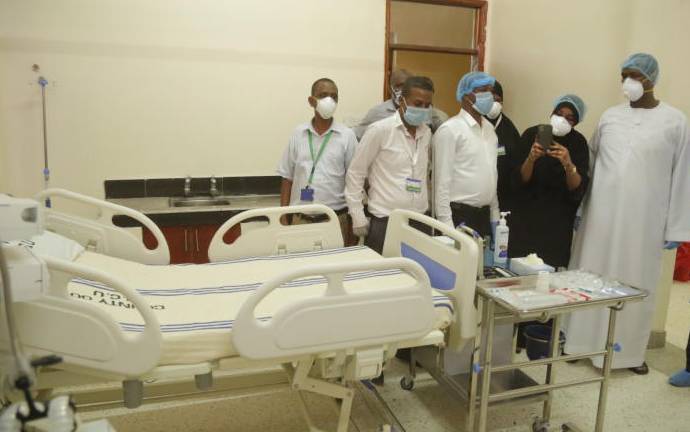
Mandera County ICU and HDU unit ready for patients. Governor Ali Roba announced county was targeting 335-bed spaces for Covid-19 patients and the county has assigned 87 health workers of different cadres dedicated to Coronavirus pandemic response. [Photo: Standard]
Even with the good news that four patients have tested negative for the coronavirus, experts say such development should not be misinterpreted that the pandemic will soon be over.
Arguments fronted by health experts and a trend of pandemics suggest that it will take at least a year before the reset button of how life was before the virus takes effect fully.
The first case of Covid-19 caused by a new strain of coronavirus was reported in December 2019 in China. As of last evening, the virus had spread to 180 countries with 962,882 confirmed cases and 49,191 deaths.
Kenya reported its first case on March 13 and has recorded three deaths and four total recoveries.
Frank Meyers, an expert in infectious diseases at UC San Diego Health Centre, US, says one of the reasons behind the uncertainty of this pandemic is that this is a new virus.
“If you look at coronaviruses in general, some of them are seasonal but we also have ones like Mers-CoV which is extremely resistant to heat, so the idea that this virus will disappear in April or May when it begins to warm up, we surely do not know the answer to that fact,” he said. “For most of my colleagues, we agree that this virus will be with us for the next one year.”
These are the same thoughts shared by Dr Gitahi Githinji, CEO of Amref Health Africa, who says that no one should think this virus will just fade off as fast as it came.
“This pandemic is not a short term social disruption, it’s going to take months before our lives go back to normal and start social gatherings,” said Dr Githinji, as he gave updates of the disease through social media.
Dr Githinji said the disease is an actual marathon and it is going to be months of public health measures, physical distance and banned gatherings. His estimation is four to five months from now.
“That will be followed by probably 12-18 months to recover from the social and economic effects (I am not an economist - just my lay estimates),” said Gitahi.
This period of 12 to 18 months is the same that the Food and Drug Administration expects a vaccine to be ready, and it would take another year for mass production for all countries in need to be on course.
However, pandemics, as history shows, seem to thrive in body counts depending on their novelty and last for just about a year, so short a time that sometimes big pharmaceuticals find no economic value to invest further in vaccines.
Asian Flu is one of such pandemics. It lasted just a year from 1957 to 1958 but it left 116,000 people dead in the United States alone. About 1.1 million people globally were infected with the H2N2 virus that causes the disease.
The virus was first reported in Singapore in February 1957. It was as well a new virus.
In 2009, United States reported a case known as the H1N1 caused by a new influenza virus. It lasted a year before it subsided and by then, 60.8 million cases had been reported, 274,304 hospitalised and 12,464 perished in the United States alone.
CDC estimated that 151,700-575,400 people worldwide died from H1N1 virus infection during the first year the virus circulated.
“Globally, 80 per cent of H1N1 virus-related deaths were estimated to have occurred in people younger than 65 years of age. This differs greatly from typical seasonal influenza epidemics, during which about 70 to 90 per cent of deaths are estimated to occur in people aged 65 years and older,” says CDC.
However, the largest pandemic of the 20th century was the Spanish Flu. The flu was not only new but the world then was not well versed with diseases and World War I did not make matters any better.
The 1918 viral Spanish Flu pandemic lasted for almost two years only ending at the end of 1919 after killing an estimated 50 million people and infecting 500 million, according to the Centre for Disease Control and Prevention.
The pandemic is argued to have started in January 1918, but the first case was documented in March 4, 1918. Like this strain of coronavirus, Spanish Flu was deadlier among the older population aged 65 and above, but it also killed healthy people majority aged between 20 and 40 years.
The high mortality of the outbreak has been linked to lack of a vaccine, and poor coordination as World Health Organisation which is spearheading response for the current pandemic was not in place.
Meyers, who is the Interim Director of Infection Prevention and Clinical Epidemiology at UC San Diego Health, says the virus is expected to circulate slowly through the community until a certain point where people will develop herd immunity.
Herd immunity works better with flu as explained by Prof Willen van Schaik from the University of Birmingham, UK.
“The major problem with coronavirus is that this is a novel virus that has never spread before, which means that everyone is at risk for infection,” said the professor in a Question and Answer paper published by Science Media Centre.
 The Standard Group Plc is a multi-media organization with investments in media platforms spanning newspaper print
operations, television, radio broadcasting, digital and online services. The Standard Group is recognized as a
leading multi-media house in Kenya with a key influence in matters of national and international interest.
The Standard Group Plc is a multi-media organization with investments in media platforms spanning newspaper print
operations, television, radio broadcasting, digital and online services. The Standard Group is recognized as a
leading multi-media house in Kenya with a key influence in matters of national and international interest.











